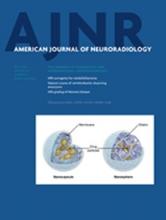Index by author
Bonafe, A.
- NeurointerventionYou have accessFlow Diversion versus Traditional Endovascular Coiling Therapy: Design of the Prospective LARGE Aneurysm Randomized TrialA.S. Turk, R.H. Martin, D. Fiorella, J. Mocco, A. Siddiqui and A. BonafeAmerican Journal of Neuroradiology July 2014, 35 (7) 1341-1345; DOI: https://doi.org/10.3174/ajnr.A3968
- NeurointerventionYou have accessImpact of Age and Baseline NIHSS Scores on Clinical Outcomes in the Mechanical Thrombectomy Using Solitaire FR in Acute Ischemic Stroke StudyM.A. Almekhlafi, A. Davalos, A. Bonafe, R. Chapot, J. Gralla, V.M. Pereira and M. Goyal on behalf of the STAR Registry InvestigatorsAmerican Journal of Neuroradiology July 2014, 35 (7) 1337-1340; DOI: https://doi.org/10.3174/ajnr.A3855
Bouffet, E.
- FELLOWS' JOURNAL CLUBExpedited PublicationOpen AccessMRI Surrogates for Molecular Subgroups of MedulloblastomaS. Perreault, V. Ramaswamy, A.S. Achrol, K. Chao, T.T. Liu, D. Shih, M. Remke, S. Schubert, E. Bouffet, P.G. Fisher, S. Partap, H. Vogel, M.D. Taylor, Y.J. Cho and K.W. YeomAmerican Journal of Neuroradiology July 2014, 35 (7) 1263-1269; DOI: https://doi.org/10.3174/ajnr.A3990
These authors seek to establish the imaging features that would allow classification of medulloblastomas according to their genetic attributes. In nearly 100 tumors they found that groups 3 and 4 occurred predominantly in the fourth ventricle, wingless ones were located in the cerebellar peduncles or CPA region, and sonic hedgehog tumors were present in cerebellar hemispheres. Midline group 4 tumors showed minimal contrast enhancement. Thus, tumor location and contrast-enhancement patterns may be predictive of the molecular subtypes of medulloblastoma.
Bruckmann, H.
- EDITOR'S CHOICENeurointerventionYou have accessUse of Flow-Diverting Devices in Fusiform Vertebrobasilar Giant Aneurysms: A Report on Periprocedural Course and Long-Term Follow-UpL. Ertl, M. Holtmannspötter, M. Patzig, H. Brückmann and G. FeslAmerican Journal of Neuroradiology July 2014, 35 (7) 1346-1352; DOI: https://doi.org/10.3174/ajnr.A3859
This article presents the authors' experience and long-term follow-up of 6 patients with fusiform and giant aneurysms of the vertebrobasilar system treated with flow-diverting devices. Devices were deployed uneventfully with no periprocedural complications. One year later, 3 patients had recurrent cerebral infarctions and 2 had acute thrombotic in-stent occlusions. Four patients died during the follow-up period. The authors do not intend to treat any more patients in this fashion until they have a better understanding of flow-diverting devices in this setting.
Butnaru, A.
- Head & NeckOpen AccessRole of Mastoid Pneumatization in Temporal Bone FracturesA. Ilea, A. Butnaru, S.A. Sfrângeu, M. Hedeşiu, C.M. Dudescu, P. Berce, H. Chezan, L. Hurubeanu, V.E. Trombiţaş, R.S. Câmpian and S. AlbuAmerican Journal of Neuroradiology July 2014, 35 (7) 1398-1404; DOI: https://doi.org/10.3174/ajnr.A3887








